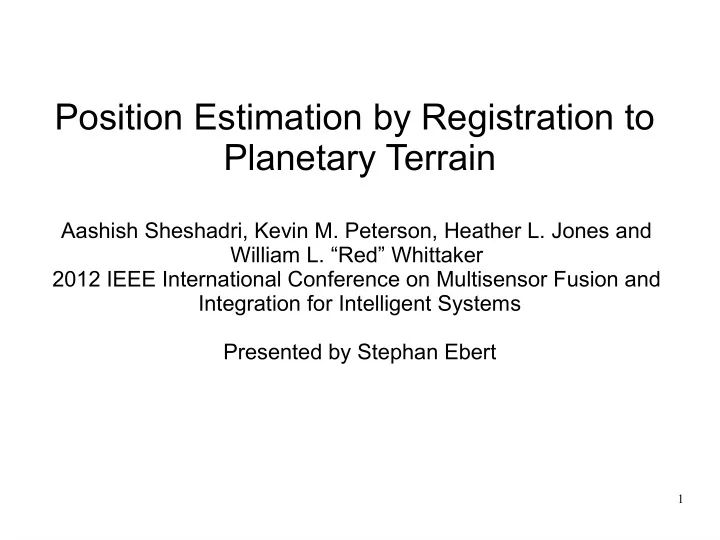

Position Estimation by Registration to Planetary Terrain Aashish Sheshadri, Kevin M. Peterson, Heather L. Jones and William L. “Red” Whittaker 2012 IEEE International Conference on Multisensor Fusion and Integration for Intelligent Systems Presented by Stephan Ebert 1
Introduction ● Autonomously localize rover on another planet using its sensor data and satellite image ● Generates local model using LIDAR and camera ● Correlates with satellite imagery ● No elevation data is necessary ● Accurate to 2 m 2
Advantages ● More efficient use of operators ● Travel out of communication range ● Absolute methods require infrastructure ● Relative methods drift over time 3
Current methods ● Terrestrial robots rely on GPS – unavailable on other planets ● Non-GPS sensor-based localization – Maps are built ahead of time using SLAM – Assume route can be driven before map is needed 4
Current methods ● Planetary rovers used combination of relative localization and human input ● Mars Exploration Rovers – Lander localized using Mars Odyssey orbiter – Wheel odometry and Inertial Measurement Unit – Visual Odometry—high processor time 5
Overview ● Rover uses camera and LIDAR to capture images of surrounding terrain ● Creates colorized point cloud ● Projected into orthographic overhead view ● Cropped into small template, which is correlated with satellite imagery 6
Building the Panorama ● Cameras and LIDAR on rotating sensor head – Motion of camera and LIDAR is know to high precision ● Rotate rover chassis – Motion not know exactly – Reconstructed with visual odometry and iterative closest point algorithm – 75% overlap required 7
Generating the template ● LIDAR point cloud projected onto camera image to produce 3D panorama ● Rotated to world-frame orientation using rover attitude – Known from stars or sun and accelerometer ● Projected to overhead orthographic image ● Create 2D image with same resolution as map imagery 8
Estimating Rover Position ● Correlate orthographic template with satellite imagery ● Search area determined by guess of rover position and uncertainty ● Normalized cross correlation between template and map interest region – Modified to ignore blank areas in template 9
Experiments ● Generated simulated datasets ● Tested accuracy and robustness under various conditions – Search area – Rover height – Lighting conditions – Map resolution ● Long term traverse 10
Simulation ● Used digital terrain map from Apollo 11 region ● Small rocks and craters added to rover view ● Generated using raytracer ● Generated camera, LIDAR, and satellite images 11
Experimental setup ● Lunar mission to find volatiles and ice ● Success defined as estimation within 2 m of actual location ● Camera and flash LIDAR on sensor head 1.5 m above the ground 12
Experimental setup ● 800 m ∙ 800 m section of the data at 0.25 m/pixel used as map ● Rover panoramas use 8 LIDAR camera image pairs over 360° ● Tested at 50 randomly chosen locations ● Angle of the sun could be adjusted 13
Localization under variation in Search Window Size ● Generate 15 m ∙ 15 m templates centered on the rover ● For each location, square search window centered on rover in varying sizes ● Sizes ranged from 25 m to 300 m in 25 m increments ● Searched for location within the search window ● Analyzed using Circular Error Probability (CEP) 14
15
Localization under Variation in Sensor Head Height ● Effect of template size on localization accuracy ● Higher head results in larger view of environment ● Size of template increased by 5 m for every 0.5 m increase in head height ● Height varied from 0.5 m to 3 m ● Template varied from 5 m to 30 m ● Tested in search windows 25 m to 300 m wide 16
17
18
NUMBER OF TEMPLATES SUCCESSFULLY LOCALIZED WITH VARIATION IN ROVER HEIGHT AND SEARCH WINDOW SIZE . Search Rover Height (m) Window 0.5 m 1.0 m 1.5 m 2.0 m 2.5 m 3.0 m 100 m 12 48 50 50 50 50 200 m 8 38 48 49 50 50 300 m 7 32 47 48 49 50 19
Localization under Variation in Lighting ● Examines effect of difference in angle between satellite image and rover image on the robustness of the localization ● Lighting angle of map was varied to simulate mismatch ● Two sets of templates: polar and equatorial ● Orthographic views generated with varied lighting for equatorial and polar conditions 20
Equatorial Polar 21
Localization under Variation in Map Resolution ● Examines localization performance as a function of overhead map resolution. ● Templates generated at resolutions from 0.25 m (original) to 1.5 m – 15 m template is 10 to 60 pixels across ● Map downsampled to match templates ● Localized in 300 m search window 22
23
5 km traverse to an interest Region ● Simulates long range travel using localization ● Two points 5 km apart were chosen and a path planned between them ● Points sampled every 100 m to generate 50 intermediate points ● Points shifted randomly ● Localized in 300 m search window 24
● Successful in 47/50 attempts ● Mean error of 0.53 m 25
Conclusion ● 94% probability of better than 2 m accuracy under nominal conditions ● Accuracy degrades with reduced template size, increased lighting angle, and decreased map resolution ● Probability increases with number of pixels in the template ● Performs well when map and rover lighting angle are within 30° ● Accuracy decreases with map resolution and increases with rover height 26
Future work ● Use template information content to determine likelihood of successful localization ● Field experimentation ● Effects of weather conditions in Earth-like environments ● Effects of sensor noise and cailibration ● Interactions between localization schemes and on-line planning and control 27
Questions? 28
Recommend
More recommend